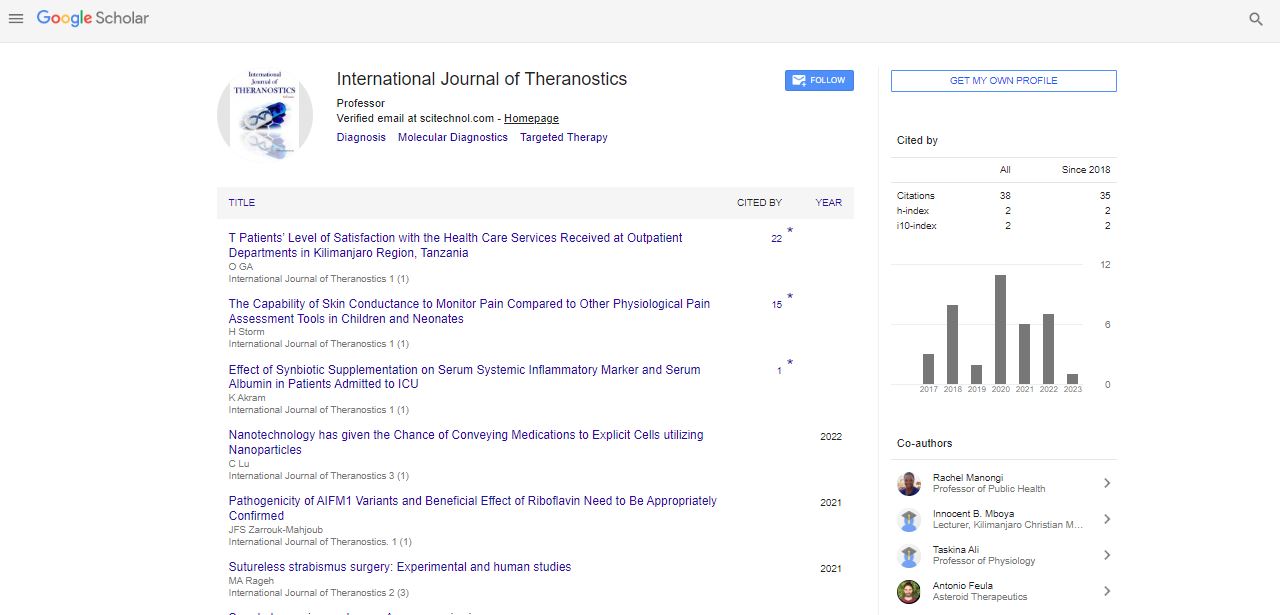Commentary, Int J Theranostic Vol: 12 Issue: 1
Theragnostics: The Convergence of Therapy and Diagnostics in Precision Medicine
Hong Song*
1Department of Radiology, Stanford University and Hospital, Stanford, United States
*Corresponding Author: Hong Song
Department of Radiology, Stanford
University and Hospital, Stanford, United States
E-mail: songhong@ac.edu
Received date: 03-Feb-2023, Manuscript No. IJT-23-95538;
Editor assigned date: 06-Feb-2023, PreQC No. IJT-23-95538 (PQ);
Reviewed date: 20-Feb-2023, QC No IJT-23-95538;
Revised date: 27-Feb-2023, Manuscript No. IJT-23-95538 (R);
Published date: 07-Mar-2023 DOI: 10.4172/IJT.100121.
Citation: Song H (2023) Theragnostics: The Convergence of Therapy and Diagnostics in Precision Medicine. Int J Theranostic 12:1.
Keywords: Diagnosis, Image-guided Therapy, Molecular Diagnostics
Description
Theragnostics is a rapidly growing field of medicine that combines diagnostic and therapeutic techniques to improve patient outcomes. It involves the use of imaging technologies to identify the precise location of a disease, followed by the targeted administration of therapy to that location. The concept of theragnostics has gained significant attention in recent years, with the potential to revolutionize the way we treat many diseases, including cancer.
Theragnostics is an approach to medicine that focuses on individualized treatment plans for patients. This approach recognizes that each patient's disease is unique and requires a personalized approach to treatment. By combining diagnostics and therapeutics, theragnostics allows physicians to tailor treatments to individual patients, resulting in better outcomes and fewer side effects.
The most common application of theragnostics is in the treatment of cancer. Traditional cancer treatments such as chemotherapy and radiation therapy are often non-specific and can damage healthy cells, leading to severe side effects. With theragnostics, however, targeted therapies can be delivered directly to cancer cells, resulting in more effective treatment with fewer side effects.
One of the key technologies used in theragnostics is Positron Emission Tomography (PET) scanning. PET scanning involves the injection of a radioactive substance into the body, which is then absorbed by cancer cells. The radioactive substance emits positrons, which can be detected by a PET scanner. This allows physicians to identify the precise location of cancer cells in the body.
Once the cancer cells have been identified, targeted therapies can be administered directly to the affected area. This can be done in a number of ways, including the use of radioisotopes, which can be delivered directly to the cancer cells, killing them without damaging healthy tissue. Radioisotopes can also be used to deliver targeted doses of radiation to cancer cells, which can be more effective than traditional radiation therapy.
Another key technology used in theragnostics is Magnetic Resonance Imaging (MRI). MRI uses powerful magnetic fields and radio waves to produce detailed images of the body. MRI can be used to identify the location of tumors and other abnormalities in the body, allowing physicians to target therapies directly to these areas.
Another key technology used in theragnostics is Magnetic Resonance Imaging (MRI). MRI uses powerful magnetic fields and radio waves to produce detailed images of the body. MRI can be used to identify the location of tumors and other abnormalities in the body, allowing physicians to target therapies directly to these areas.
One of the major advantages of theragnostics is that it allows physicians to monitor the effectiveness of treatments in real-time. By using imaging technologies to track the progress of a disease, physicians can adjust treatment plans as needed, ensuring that patients receive the most effective therapies possible. This can lead to better outcomes and fewer side effects for patients.
 Spanish
Spanish  Chinese
Chinese  Russian
Russian  German
German  French
French  Japanese
Japanese  Portuguese
Portuguese  Hindi
Hindi 